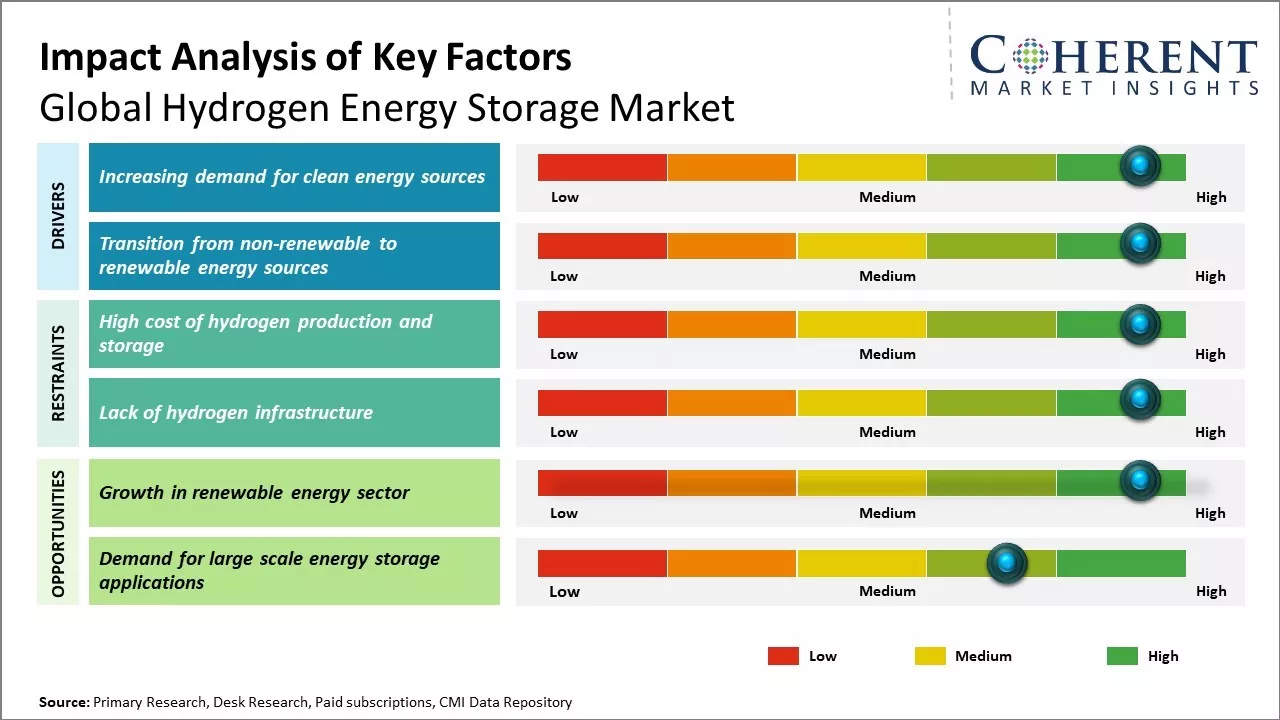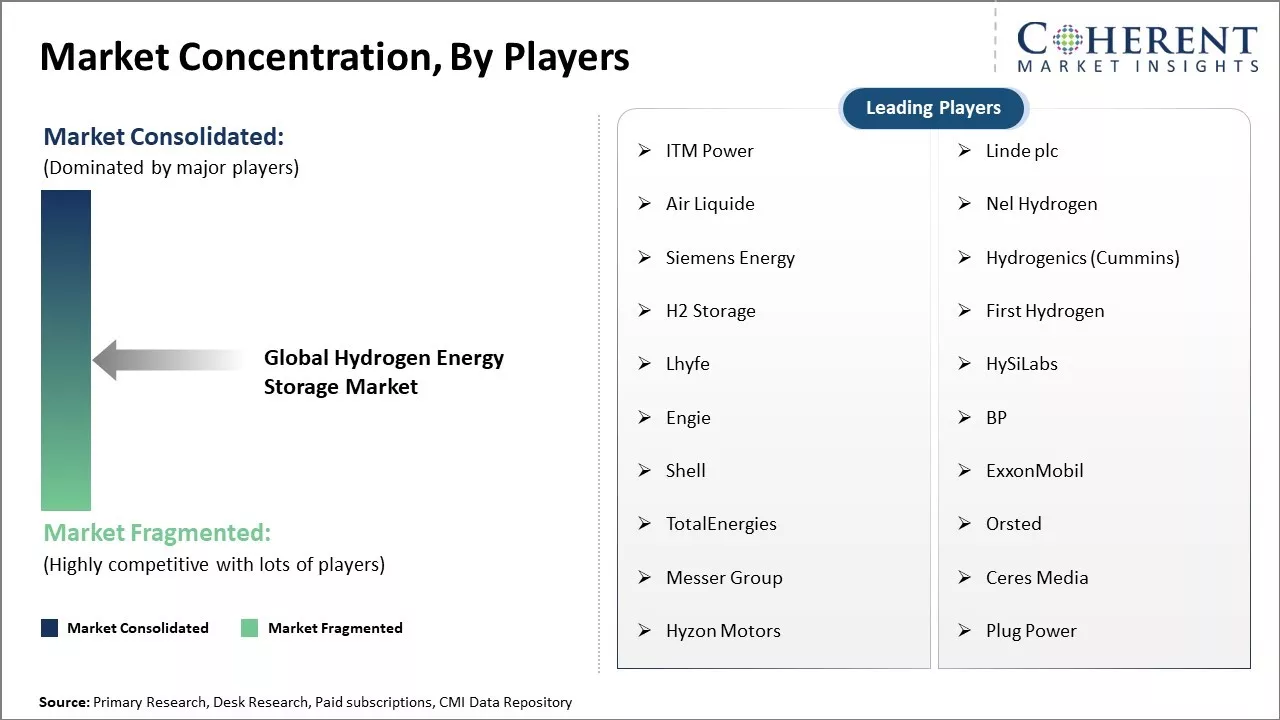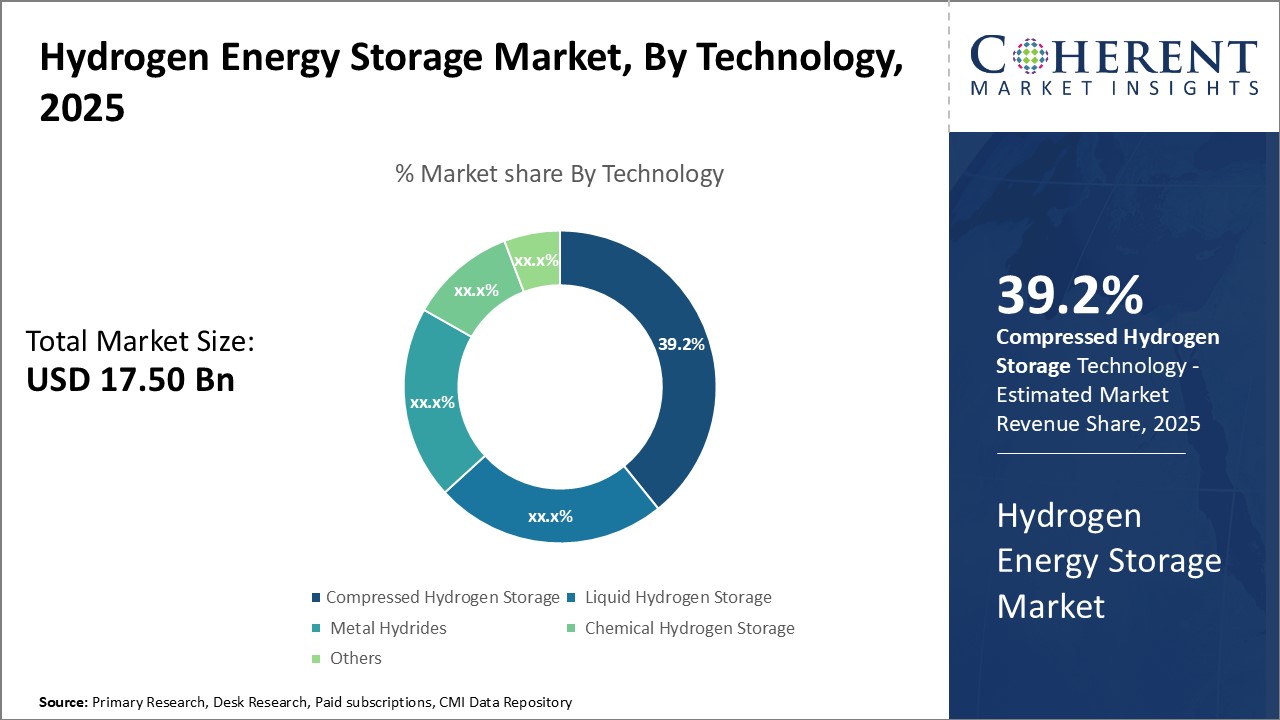Hydrogen Energy Storage Market Size and Forecast 2025- 2032
The global hydrogen energy storage market is estimated to be valued at USD 17.50 Bn in 2025 and is expected to reach USD 24.32 Bn by 2032, exhibiting a compound annual growth rate (CAGR) of 4.8% from 2025 to 2032.

To learn more about this report, Download Free Sample
Key Takeaways of the Hydrogen Energy Storage Market
- By technology, the compressed hydrogen storage segment is expected to account for 39.2% share in 2025.
- In terms of application, the power generation segment is projected to hold 34.1% in 2025.
- North America is expected to lead the global market with 36.1% share in 2025.
Market Overview
The hydrogen energy storage market is seeing positive trends owing to the increasing demand for sustainable energy and the need to decarbonize energy intensive industries. Many countries such as China, India, and others are supporting the development of hydrogen technologies and infrastructure through policies and public funding to meet their decarbonization goals. Both utilities scale projects as well as behind-the-meter distributed hydrogen energy storage systems are gaining traction.
The cost of renewable hydrogen production is declining steadily making it competitive with fossil fuel alternatives. Investments in hydrogen production using fuel cells and electrolysis technologies are growing globally which is positively impacting the market growth.
Market Concentration and Competitive Landscape

To learn more about this report, Download Free Sample
Current Events and Their Impact on the Hydrogen Energy Storage Market
|
Current Events |
Description and its impact |
|
Government initiatives |
|
|
Technological advancements |
|
Uncover macros and micros vetted on 75+ parameters: Get instant access to report
Market Trends
Energy Transition Goals and Increased Government Initiatives
The hydrogen energy storage is growing rapidly as countries reinforce efforts to decarbonize energy systems. Governments across the globe are coming up with ambitious roadmaps in order to support long duration energy storage and renewable integration. The U.S. infrastructure investment and jobs Act has allocated US$ 9.5 billion for hydrogen development, while the European Union has approved €3.2 billion in state aid for cross-border hydrogen core network.
Technological Advancements in the Storage Methods
Recent advancements in hydrogen storage technologies such as liquefaction, compression, and solid-state storage are driving increased adoption. Compression storage holds over 40% of the market share; however, liquefication is the emerging as the fastest-growing segment because of its suitability for large scale transportation and industrial applications. New materials like chemical and metal are also being explored to ensure safety and enhance efficiency and storage capacity in order to support the integration into renewable- heavy energy grids.
Market Opportunity - Growth in renewable energy sector
The growing focus on developing renewable sources of energy like solar and wind globally presents a massive opportunity for the hydrogen energy storage market. As the integration of variable renewable energy increases, long-term and large-scale storage solutions will be crucial to ensure grid reliability and stabilize power supply. Hydrogen energy storage has strong potential to facilitate the large-scale adoption of renewable energy by enabling seasonally-based energy storage. Globally, investments in the grid-scale energy storage are expected to reach over USD 400 billion by 2030. Additionally, growing investment in renewable energy sector is expected to drive the market growth. For instance, according to data by International Energy Agency, in 2020, global investment in solar energy reached US$ 148.6 billion, demonstrating the sector's attractiveness to investors.
Hydrogen Energy Storage Market Insights, by Technology
In terms of technology, compressed hydrogen storage segment is expected to contribute 39.2% share of the market in 2025 due to its advantages over other technologies.
Vehicles like cars, buses, and trucks have very limited space available for an energy storage system. Compressed hydrogen storage allows them to drive further on less storage volume. The compressed tanks can also be rapidly filled to capacity, facilitating faster refueling times similar to gas stations. This ease of operation and refueling accessibility makes compressed storage the technology of choice for hydrogen fuel cell vehicles and other mobile machinery.
Moreover, compressed hydrogen cylinders are relatively lightweight and very durable containers. Overall transportation costs are lower for compressed hydrogen versus liquid form. Industries relying on hydrogen fuel in remote locations far from gas pipelines also prefer compressed storage for its simple logistical handling.
Hydrogen Energy Storage Market Insights by application
In terms of application, the power generation segment is expected to contribute 34.1% of the market share in 2025. Globally, the growing power generation sector is expected to drive the segment growth.
For instance, according to data by the Ministry of Power released in 2022, the electricity generation target for 2023-24 is 1,750 billion units (BU), which is a 7.2% increase from the previous year's generation of 1,624.158 BU. Many countries and regions like India, China and other have ambitious targets to reduce carbon emissions from electricity grids and transition to low-carbon energy sources.
Regional Insights

To learn more about this report, Download Free Sample
North America Hydrogen Energy Storage Market Trends and Analysis
North America has established itself as the dominant regional market for hydrogen energy storage. The region is expected to hold 36.1% of the market share in 2025. The large presence of major fuel cell and hydrogen technology developers in countries like the U.S. has enabled significant advancements in the core hydrogen infrastructure. Government initiatives promoting clean energy coupled with high industrial investments have helped develop a robust supply chain and manufacturing base for hydrogen energy related products across applications. The established leadership in sectors like transportation also augments the regional hydrogen economy.
Asia Pacific Hydrogen Energy Storage Market Trends and Analysis
Asia Pacific is emerging as the fastest growing regional market. Rapid economic expansion and growing energy demands make it an attractive market for new energy technologies. Countries like Japan, South Korea, and China are aggressively investing in hydrogen infrastructure to reduce fossil fuel import dependence and meet sustainability goals. As global leaders in renewable energy adoption, focus on hydrogen provides a viable clean energy storage solution for these markets. Additionally, the presence of leading automobile manufacturers is directing efforts towards developing the global hydrogen energy storage market.
U.S. Hydrogen Energy Storage Market Trends and Analysis
The U.S. hydrogen energy storage market is growing rapidly driven by the growing need for clean energy and its role in utilizing renewable power. The innovations in the government support and the storage technologies are the main factors driving this expansion. For instance, Hydrogen and Fuel Cell Technologies Office of the U.S. Department of Energy is developing onboard automative hydrogen storage systems.
India Hydrogen Energy Storage Market Trends and Analysis
India is advancing in the development of hydrogen storage technologies, including high-pressure and liquefied hydrogen tanks, pipelines, and composite materials for safer and more efficient storge and transport. For instance, the government of India launched the national green hydrogen mission in 2023. The government of India allocated ₹19,744 crore, aiming to establish a production capacity of 5 million metric ton of green hydrogen per year by 2030.
Impact of AI on Hydrogen Energy Storage Market
The integration of Artificial Intelligence (AI) into the hydrogen energy storage sector is revolutionizing traditional methodologies, driving efficiency, and enhancing decision-making processes.
- A prominent example is Siemens Energy, which employs AI-driven digital twin technology to simulate and optimize hydrogen electrolyzer performance.
- ITM power, a U.K. based company, has used AI for enhancing the performance of its Hydrogen electrolysis. Also, the company has entered into a collaboration with Optimal Group to develop hydrogen production and deliver predictive analytics for performance improvement.
Manufacturing Units
- Plug Power Inc. - Innovation Centre & Manufacturing Facility
-
- Plug Power Inc., headquartered in the U.S., operates an Innovation Centre and Manufacturing Facility. This facility is focused on high-capacity PEM electrolyzers, fuel cells, and integrated hydrogen energy storage solutions.
- The facility has annual production capacity of 500 MW, with plans to scale up to 2 GW per year in the near future.
Emerging Applications in the Hydrogen Energy Storage Market
- Emerging Application Area
-
- Hydrogen powered data centres: Microsoft and Google are experimenting with hydrogen fuel cells to power their data centres.
- Hydrogen-powered heavy-duty vehicles: Companies like Hyundai, Toyota, and Nikola are investing in hydrogen fuel-cell technology to develop zero-emission solutions for the transportation sector.
Market Report Scope
Hydrogen Energy Storage Market Report Coverage
| Report Coverage | Details | ||
|---|---|---|---|
| Base Year: | 2024 | Market Size in 2025: | USD 17.50 Bn |
| Historical Data for: | 2020 To 2024 | Forecast Period: | 2025 To 2032 |
| Forecast Period 2025 to 2032 CAGR: | 4.8% | 2032 Value Projection: | USD 24.32 Bn |
| Geographies covered: |
|
||
| Segments covered: |
|
||
| Companies covered: |
ITM Power, Linde plc, Air Liquide, Nel Hydrogen, Siemens Energy, Hydrogenics (Cummins), H2 Storage, First Hydrogen, Lhyfe, HySiLabs, Engie, BP, Shell, ExxonMobil, TotalEnergies, Orsted, Messer Group, Ceres Media, Hyzon Motors, and Plug Power |
||
| Growth Drivers: |
|
||
| Restraints & Challenges: |
|
||
Uncover macros and micros vetted on 75+ parameters: Get instant access to report
Hydrogen Energy Storage Industry News
- In February 2024, the Union Minister for New & Renewable Energy and Power outlined the government's proactive measures to foster a vibrant research and development ecosystem aimed at commercializing green hydrogen. This initiative is part of the broader framework established under the National Green Hydrogen Mission, which was launched by the government of India in January 2023.
- In 2023, Chevron, a leading global energy company, announced its acquisition of a majority stake in the Advanced Clean Energy Storage (ACES) hydrogen project located in Delta, Utah. This strategic move underscores Chevron's commitment to expanding its portfolio in renewable energy and advancing the development of clean hydrogen solutions.
- In 2024, Elcogen laid the cornerstone for a new 14,000 square meter factory in the loovalja industrial park near Tallinn, Estonia. This facility is expected to substantially increase Elcogen’s production capacity of solid oxide cells and stacks, which are important for both green hydrogen production and emission-free electricity generation.
- In the late 2024, the Indian Hydrogen Alliance suggested for the execution of mandates that requires the use of green hydrogen in the industrial sectors such as ammonia production facilities and oil refineries.
Analyst View
- The global hydrogen energy storage market is growing rapidly, directed by the increasing need for sustainable technologies and cleaner energy. The role of hydrogen in decarbonizing sectors like transportation and integrating renewables is a key factor.
- The advancements of technology in fuel cells and electrolysis, combined with the cost reductions from economies of scale, will be important in making hydrogen solutions economically more stable making it wider for adoption across various industries.
- Global momentum is growing, with meaningful initiatives and investments in regions like the Asia Pacific and North America. Challenges like safety hazards and initial costs through the improved collaboration amongst the stakeholders will be crucial to realize hydrogen’s economic and environmental potential.
Market Segmentation
- By Technology Insights (Revenue, USD Bn, 2020 - 2032)
- Compressed Hydrogen Storage
- Liquid Hydrogen Storage
- Metal Hydrides
- Chemical Hydrogen Storage
- Others
- Application Insights (Revenue, USD Bn, 2020 - 2032)
- Power Generation
- Transportation
- Industrial Uses
- Residential and Commercial
- Others
- Regional Insights (Revenue, USD Bn, 2020 - 2032)
- North America
- U.S.
- Canada
- Latin America
- Brazil
- Argentina
- Mexico
- Rest of Latin America
- Europe
- Germany
- U.K.
- Spain
- France
- Italy
- Russia
- Rest of Europe
- Asia Pacific
- China
- India
- Japan
- Australia
- South Korea
- ASEAN
- Rest of Asia Pacific
- Middle East
- GCC Countries
- Israel
- Rest of Middle East
- Africa
- South Africa
- North Africa
- Central Africa
- Key Players Insights
-
- ITM Power
- Linde plc
- Air Liquide
- Nel Hydrogen
- Siemens Energy
- Hydrogenics (Cummins)
- H2 Storage
- First Hydrogen
- Lhyfe
- HySiLabs
- Engie
- BP
- Shell
- ExxonMobil
- TotalEnergies
- Orsted
- Messer Group
- Ceres Media
- Hyzon Motors
- Plug Power
Sources
Stakeholders:
- Hydrogen System and Equipment Manufacturers
- Energy Storage Solution Providers
- Hydrogen Energy Project Developers
- Industry Consultants & Analysts
- Others
Databases:
- Bloomberg New Energy Finance (BNEF)
- International Energy Agency (IEA) Data Services
- U.S. Energy Information Administration (EIA)
- Others
Magazines:
- Hydrogen Fuel News
- Renewable Energy Magazine
- Energy Storage Journal
- Others
Journals:
- International Journal of Hydrogen Energy
- Journal of Energy Storage
- Journal of Power Sources
- Others
Newspapers:
- The Guardian (Energy & Environment Section)
- Financial Times (Energy Sector)
- The Economic Times (Energy coverage)
- Others
Associations:
- International Association for Hydrogen Energy (IAHE)
- Hydrogen Council
- Fuel Cell & Hydrogen Energy Association (FCHEA)
- Energy Storage Association (ESA)
- Others
Public Domain Sources:
- U.S. Department of Energy (DOE)
- European Commission - Energy Directorate
- International Renewable Energy Agency (IRENA)
- Office of Energy Efficiency & Renewable Energy (EERE)
- Others
Proprietary Elements:
CMI Data Analytics Tool, Proprietary CMI Existing Repository of Information for last 8 years
*Definition: The global hydrogen energy storage market involves the production, storage, and distribution of hydrogen as an energy storage medium on a global scale. It utilizes hydrogen's ability to be produced from multiple energy sources, stored for later use and converted back to electricity through fuel cells. As more renewable and clean energy sources like solar and wind come online worldwide, the global hydrogen energy storage market provides an efficient way to store intermittent renewable energy for stationary and mobile application.
Share
Share
Missing comfort of reading report in your local language? Find your preferred language :
Transform your Strategy with Exclusive Trending Reports :
Frequently Asked Questions
EXISTING CLIENTELE
Joining thousands of companies around the world committed to making the Excellent Business Solutions.
View All Our Clients

